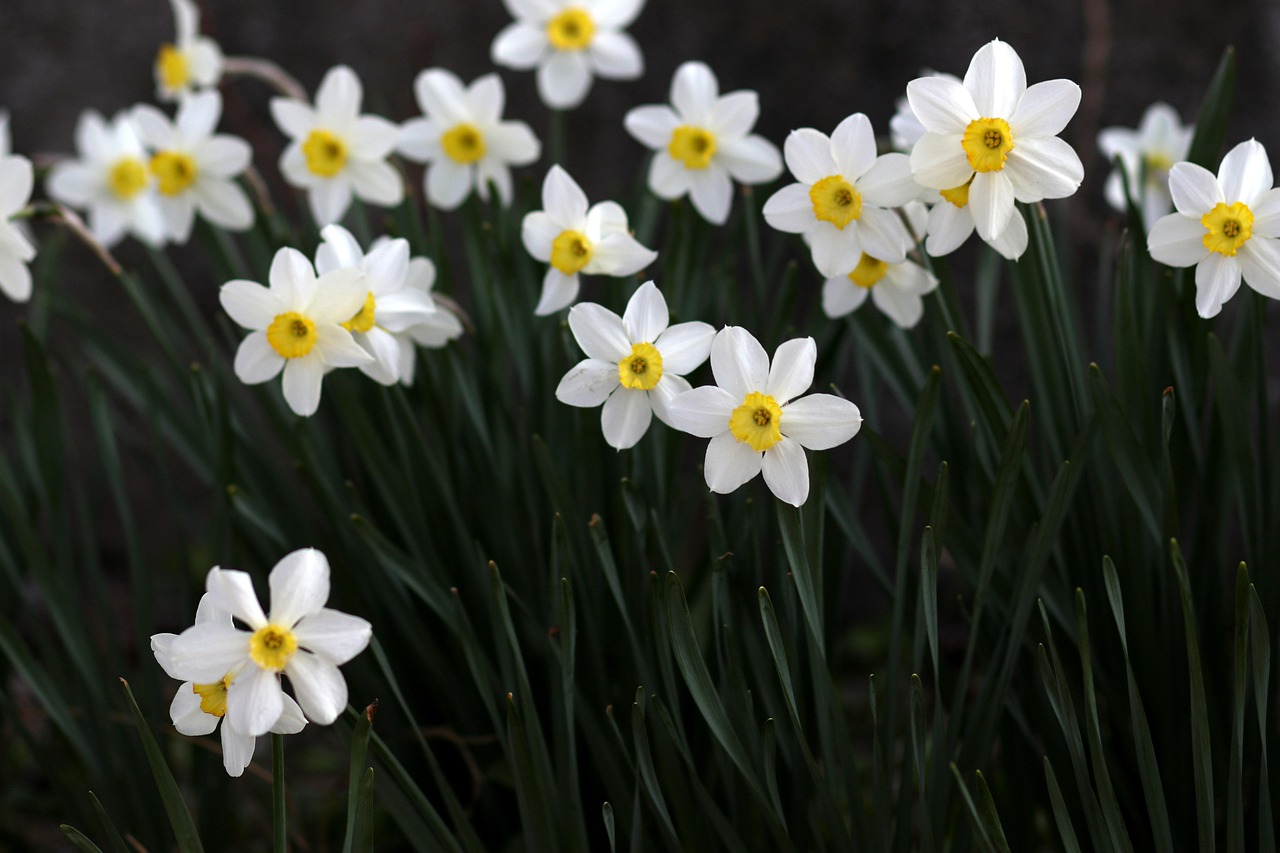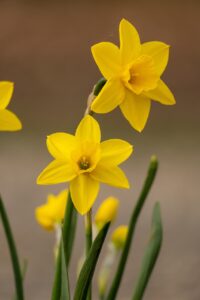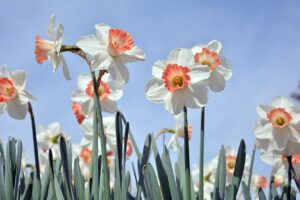Daffodil
Overview
The Daffodil, a splash of spring’s cheer, is a perennial favorite that brightens gardens with its striking flowers. With origins spanning Europe to North Africa, these resilient plants are known not only for their beauty but also their adaptability to various climates. Though toxic if ingested, Daffodils remain a staple in ornamental horticulture, requiring careful placement and specific conditions to flourish.

Characteristics
Known for its vibrant, trumpet-shaped flowers and as a herald of spring.
Region
Native to Europe and North Africa, widely adapted to most regions of North America, except very hot, wet areas.
Natural Habitat
Found in open meadows, woodlands, and riverbanks.
Cultivation
Requires at least six hours of daily sunlight, well-drained, slightly acidic soil, and moderate watering, avoiding waterlogged conditions.
Uses and Benefits
The dainty Daffodil, while largely admired for its vibrant blossoms, isn’t just a feast for the eyes. Its primary role in our gardens is ornamental, painting landscapes with splendid hues as spring dawns. However, it’s essential to be mindful that this beauty holds a secret—Daffodils contain toxic properties2.
Throughout history, Daffodils have been used medicinally, although extreme caution is warranted due to their toxicity. Some traditional practices leveraged their compounds for emetic and cathartic properties. Yet, in today’s world, the risks associated with their use often outweigh the potential medicinal benefits.
In terms of ecological benefits, Daffodils offer some assistance to local wildlife. While they may not provide nectar due to their toxicity, they can offer other environmental advantages, such as:
- Serving as a vivid reminder that spring has arrived
- Signaling the time for other plants to awaken from their winter slumber
- Providing ground cover and preventing soil erosion
- Adding visual interest to gardens and natural areas
When considering Daffodils for your garden, keep these points in mind:
- Toxicity: Daffodils contain toxic compounds, so handle them with care and keep them away from children and pets.
- Companion planting: Plant Daffodils alongside other early-blooming flowers for a stunning spring display.
- Naturalizing: Allow Daffodils to naturalize and spread over time for a more organic look in your garden.
By appreciating the Daffodil’s beauty and understanding its characteristics, you can enjoy its ornamental value while being mindful of its limitations.

Cultivation Tips
To cultivate your Daffodils successfully, select a well-draining site that basks in at least six hours of sunlight each day. In hotter regions, consider adding some afternoon shade to protect the vibrant hues of your blossoms.
For optimal results, plant your Daffodils in mid to late autumn, about a month before your area’s expected last frost date. This timing allows the bulbs to establish strong roots before the winter chill sets in.
To ensure your Daffodils thrive, pay attention to soil conditions:
- Aim for slightly acidic soil with a pH between 6.0 and 6.5.
- If your soil is too alkaline, a dash of soil sulfur can help adjust the pH to the ideal range.
- Well-draining soil is crucial to prevent bulb rot, so avoid overwatering or planting in poorly draining areas.
When planting, follow these guidelines for success:
- Dig holes about 3 times as deep as the bulb’s height, typically 6 to 8 inches deep.
- Space the holes 4 to 6 inches apart, depending on the variety.
- Place the bulbs pointy-end up and cover with soil, gently firming it around the bulbs.
- Water thoroughly after planting to settle the soil and encourage root growth.
With these cultivation tips in mind, you’ll be well on your way to enjoying a delightful display of Daffodils in your garden4.
Seasonal Considerations
To ensure your Daffodils thrive, choose a location that offers good drainage and receives a minimum of six hours of sunlight daily. In regions with higher temperatures, providing some shade in the afternoon can help preserve the vibrant colors of your blooms.
For optimal results, plant your Daffodils between the middle and end of autumn. This timing allows the bulbs to establish themselves before the winter frost, ensuring a spectacular display about a month before the last expected frost date in your area.
Daffodils prefer slightly acidic soil. If your soil is not naturally acidic, you can easily adjust the pH by incorporating a small amount of soil sulfur. Be cautious not to overwater your Daffodils, as this can lead to bulb rot, which can be detrimental to the health of your plants. By following these simple guidelines, you’ll be rewarded with a stunning showcase of Daffodils in your garden4.

Issues and Troubleshooting
If you find your cheerful Daffodils wilting or failing, there’s likely a simple explanation—and solution. Overly wet soil is a common culprit leading to root rot. To prevent this soggy scenario, ensure proper drainage when planting. If you’ve got them in heavy soils, consider amending it with sand or organic matter to keep things airy and dry.
Should your Daffodils’ blooms seem lackluster and fleeting, remember that they crave the sun’s rays. Aim for at least six hours of direct sunlight but do give them a little shade in hotter regions to protect their vibrant hues. And don’t forget, a touch of soil sulfur can correct alkaline soils, mimicking their preferred slightly acidic home ground.
When the colors of your Daffodils start to fade or flowers become less abundant, it might be a sign to divide crowded clumps. Every few years, gently lift and separate the bulbs after the foliage dies back. This’ll reinvigorate your Daffodils and encourage a stunning display come springtime.
Remember, these plants are toxic, so handle with care and keep pets at a paw’s length2 4.
Other issues that may arise with Daffodils include:
- Pests such as narcissus bulb flies or nematodes4. Regularly inspect your plants and treat infestations promptly.
- Fungal diseases like basal rot or leaf spot. Ensure good air circulation around the plants and avoid overwatering to prevent these issues.
- Failure to bloom due to improper storage or planting depth of the bulbs. Store bulbs in a cool, dry place and plant them at the correct depth for optimal flowering.
With a little troubleshooting and TLC, you can keep your Daffodils thriving and putting on a spectacular show year after year.
History and Folklore
Daffodils, with their bright and cheerful blossoms, are not just a herald of spring but also carry with them a tapestry of history and lore. In the annals of mythology, these flowers are inextricably linked to the Greek legend of Narcissus, a beautiful youth who fell in love with his own reflection. Tragically, he stared at it until he turned into a daffodil flower; this myth gave rise to the plant’s genus name, Narcissus1.
The Victorian era saw daffodils take on a new meaning, as they came to signify regard and chivalry. However, the symbolism of daffodils was not always so positive. In some traditions, they were associated with good fortune, while in others, they were seen as harbingers of misfortune if brought indoors. Despite these conflicting stories, one thing remains constant—daffodils have captivated humans through the ages with their resilience and beauty.
The history of daffodils is not just limited to mythology and folklore. In fact, these flowers have been cultivated for centuries, with the earliest known cultivation dating back to ancient Egypt. The Romans also grew daffodils, and they were later introduced to England by the Normans in the 11th century.
Throughout history, daffodils have been used for various purposes, including:
- Medicinal uses, such as treating wounds and burns
- Creating perfumes and fragrances
- Adorning gardens and public spaces
- Inspiring art and literature, such as William Wordsworth’s famous poem “I Wandered Lonely as a Cloud”
Today, daffodils continue to be a beloved symbol of spring and a popular choice for gardens and floral arrangements. With their rich history and enduring beauty, it’s no wonder that these flowers have captured the hearts and imaginations of people for centuries.
References
1. Narcissus (plant) – Wikipedia, https://en.wikipedia.org/wiki/Narcissus_(plant)
2. How to Grow and Care for Daffodils – The Spruce, https://www.thespruce.com/planting-and-growing-daffodils-1402136
3. Growing Daffodils: When to Plant Daffodils, How to Plant Daffodils…, https://www.almanac.com/plant/daffodils
4. Daffodil: How to Grow and Care with Success – Gardenia, https://www.gardenia.net/guide/learn-how-to-plant-and-care-for-daffodils
5. Guidelines for Growing Daffodils | American Daffodil Society, https://daffodilusa.org/growing-daffodils/guidelines-for-growing-daffodils/
Image Credit: AdinaVoicu
Image Credit: eignatik17
Image Credit: kareni
Nicolas Duval
Nicolas is a passionate advocate for nature and the art of wildcrafting. His dedication shines through in Wildcraftia, a website he meticulously crafted to serve as a haven for nature enthusiasts worldwide. Driven by a deep appreciation for nature’s connection to humanity, Nicolas embarked on his journey in 2011 with SmokableHerbs, a platform showcasing his love for nature’s bounty. Building upon this foundation, he established Smokably, a thriving online store offering premium herbs and blends to a global audience.
